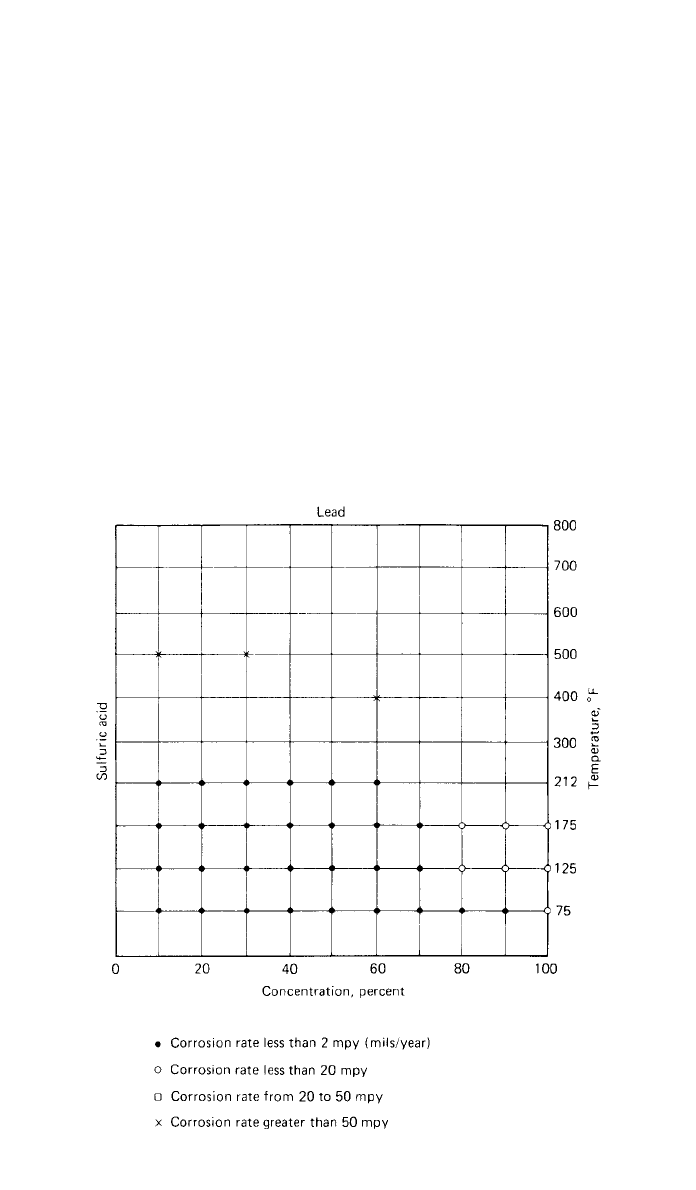Kutz M. Handbook of materials selection
Подождите немного. Документ загружается.


7 FRETTING AND WEAR 759
Table 7 Adhesive Wear Behavior of Various Pairs
a
Description of Metal Pair
Material Combination
Al
Disk
Steel
Disk
Cu
Disk
Ag
Disk Remarks
Soluble pairs with poor
adhesive wear resis-
tance
Be
Mg
Al
Si
Ca
Ti
Cr
—
Fe
Co
Ni
Cu
—
Zr
Nb
Mo
Rh
—
Ag
—
—
Sn
Ce
Ta
W
—
Pt
Au
Th
U
Be
—
Al
Si8
—
Ti
Cr
Mn
Fe
Co
Ni
—
Zn
Zr
Nb
Mo
Rh
Pd
—
—
—
—
Ce
Ta
W
Ir
Pt
Au
Th
U
Be
Mg
Al
Si
Ca
Ti
—
—
—
Co
Ni
Cu
Zn
Zr
Nb
Mo
Rh
—
Ag
Cd
In
Sn
Ce
Ta
W
—
Pt
Au
Th
U
Be
Mg
—
Si
—
—
—
—
—
—
—
—
—
Zr
—
—
—
—
—
Cd
In
—
—
—
—
—
—
Au
Th
U
These pairs substantiate the criteria
of solubility and B subgroup
metals
Soluble pairs with fair or
good adhesive wear
resistance. (F)
⫽ Fair
—
Zn(F)
—
Cu(F)
—
—
—
—
Sb(F)
These pairs do not substantiate the
stated criteria
Insoluble pairs, neither
from the B subgroup,
with poor adhewsive
wear resistance
Li
Mg
Ca
Ba
These pairs substantiate the stated
criteria
Insoluble pairs, one from
the B subgroup, with
fair or good adhesive
wear resistance. (F)
⫽
Fair
—
—
—
—
—
—
—
—
—
Cd
Ln
—
—
Te(F)
Ti
Pb(F)
Bi(F)
C(F)
—
—
—
—
—
Se(F)
—
Ag
Cd
In
Sn(F)
Sb(F)
Te(F)
Ti
Pb
Bi
—
—
Cr(F)
—
—
Ge(F)
Se(F)
—
—
—
—
—
Sb
Te(F)
Ti
Pb
Bi(F)
—
Ti(F)
Cr(F)
Fe(F)
Co(F)
—
—
Nb(F)
—
—
—
—
—
—
—
—
—
These pairs substantiate the stated
criteria
Insoluble pairs, one from
the B subgroup, with
poor adhesive wear re-
sistance
C
—
Se
—
—
—
—
—
C
—
—
—
C
Ni
—
Mo
These pairs do not substantiate the
stated criteria
a
See pp. 34–35 of Ref. 72.

760 FAILURE MODES
Table 8 Abrasive Wear Constant 3(tan
)
m
/
for Various
Materials in Sliding Contact as Reported by Different
Investigators
Materials Wear Type
Particle Size
(
m) 3(tan
)
m
/
Many
Many
Many
Steel
Many
Brass
Steel
Steel
Many
Two body
Two body
Two body
Two body
Two body
Two Body
Three body
Three body
Three body
—
110
40–150
260
80
70
150
80
40
180
⫻ 10
⫺
3
150 ⫻ 10
⫺
3
120 ⫻ 10
⫺
3
80 ⫻ 10
⫺
3
24 ⫻ 10
⫺
3
16 ⫻ 10
⫺
3
6 ⫻ 10
⫺
3
4.5 ⫻ 10
⫺
3
2 ⫻ 10
⫺
3
Source: See p. 169 of Ref. 71. Reprinted with permission from
John Wiley & Sons.
Table 9 Values of (Hardness / Modulus of Elasticity)
for Various Materials
Material Condition
BHN
a
(E ⫻ 10 )
⫺6
(in mixed units)
Alundum (Al
2
O
3
) Bonded 143
Chrome plate Bright 83
Gray ion Hard 33
Tungsten carbide 9% Co 22
Steel Hard 21
Titanium Hard 17
Aluminum alloy Hard 11
Gray iron As cast 10
Structural steel Soft 5
Malleable iron Soft 5
Wrought iron Soft 3.5
Chromium metal As cast 3.5
Copper Soft 2.5
Silver Pure 2.3
Aluminum Pure 2.0
Lead Pure 2.0
Tin Pure 0.7
a
Brinell hardness number.
Source: Reprinted from Ref. 59, Copyright 1957, with per-
mission from Elsevier Science.
In selecting materials for abrasive wear resistance, it has been established that
both hardness and modulus of elasticity are key properties. Increasing wear
resistance is associated with higher hardness and lower modulus of elasticity
since both the amount of elastic deformation and the amount of elastic energy
that can be stored at the surface are increased by higher hardness and lower
modulus of elasticity.
Table 9 tabulates several materials in order of descending values of (hardness)/
(modulus of elasticity). Well-controlled experimental data are not yet available,
but general experience would provide an ordering of materials for decreasing

8 CORROSION AND STRESS CORROSION 761
wear resistance compatible with the array of Table 9. When the conditions for
adhesive or abrasive wear exist together with conditions that lead to corrosion,
the two processes persist together and often interact synergistically. If the cor-
rosion product is hard and abrasive, dislodged corrosion particles trapped be-
tween contacting surfaces will accelerate the abrasive wear process. In turn, the
wear process may remove the ‘‘protective’’ surface layer of corrosion product
to bare new metal to the corrosive atmosphere, thereby accelerating the corrosion
process. Thus, the corrosion wear process may be self-accelerating and may lead
to high rates of wear.
On the other hand, some corrosion products, for example, metallic phos-
phates, sulfides, and chlorides, form as soft lubricative films that actually im-
prove the wear rate markedly, especially if adhesive wear is the dominant
phenomenon.
Three major wear control methods have been defined, as follows (see p. 36
of Ref. 72): principle of protective layers, including protection by lubricant,
surface film, paint, plating, phosphate, chemical, flame-sprayed, or other types
of interfacial layers; principle of conversion, in which wear is converted from
destructive to permissible levels through better choice of metal pairs, hardness,
surface finish, or contact pressure; and principle of diversion, in which the wear
is diverted to an economical replaceable wear element that is periodically dis-
carded and replaced as ‘‘wear out’’ occurs.
When two surfaces operate in rolling contact, the wear phenomenon is quite
different from the wear of sliding surfaces just described, although the ‘‘delam-
ination’’ theory
73
is very similar to the mechanism of wear between rolling sur-
faces in contact as described here. Rolling surfaces in contact result in Hertz
contact stresses that produce maximum values of shear stress slightly below the
surface. (See, for example, Ref. 74.) As the rolling contact zone moves past a
given location on the surface, the subsurface peak shear stress cycles from zero
to a maximum value and back to zero, thus producing a cyclic stress field. Such
conditions may lead to fatigue failure by the initiation of a subsurface crack that
propagates under repeated cyclic loading and that may ultimately propagate to
the surface to spall out a macroscopic surface particle to form a wear pit. This
action, called surface fatigue wear, is a common failure mode in antifriction
bearings, gears, and cams, and all machine parts that involve rolling surfaces in
contact.
8 CORROSION AND STRESS CORROSION
Corrosion may be defined as the undesired deterioration of a material through
chemical or electrochemical interaction with the environment, or destruction of
materials by means other than purely mechanical action. Failure by corrosion
occurs when the corrosive action renders the corroded device incapable of per-
forming its design function. Corrosion often interacts synergistically with an-
other failure mode, such as wear or fatigue, to produce the even more serious
combined failure modes, such as corrosion wear or corrosion fatigue. Failure by
corrosion and protection against failure by corrosion has been estimated to cost
in excess of $8 billion annually in the United States alone.
75
The complexity of the corrosion process may be better appreciated by rec-
ognizing that many variables are involved, including environmental, electro-

762 FAILURE MODES
chemical, and metallurgical aspects. For example, anodic reactions and rate of
oxidation; cathodic reactions and rate of reduction; corrosion inhibition, polari-
zation, or retardation; passivity phenomena; effect of oxidizers; effect of veloc-
ity; temperature; corrosive concentration; galvanic coupling; and metallurgical
structure all influence the type and rate of the corrosion process.
Corrosion processes have been categorized in many different ways. One con-
venient classification divides corrosion phenomena into the following types
75,76
:
1. Direct chemical attack
2. Galvanic corrosion
3. Crevice corrosion
4. Pitting corrosion
5. Intergranular corrosion
6. Selective leaching
7. Erosion corrosion
8. Cavitation corrosion
9. Hydrogen damage
10. Biological corrosion
11. Stress corrosion cracking
Depending on the types of environment, loading, and mechanical function of
the machine parts involved, any of the types of corrosion may combine their
influence with other failure modes to produce premature failures. Of particular
concern are interactions that lead to failure by corrosion wear, corrosion fatigue,
fretting fatigue, and corrosion-induced fracture.
8.1 Types of Corrosion
Direct chemical attack is probably the most common type of corrosion. Under
this type of corrosive attack the surface of the machine part exposed to the
corrosive media is attacked more or less uniformly over its entire surface, re-
sulting in a progressive deterioration and dimensional reduction of sound load-
carrying net cross section. The rate of corrosion due to direct attack can usually
be estimated from relatively simple laboratory tests in which small specimens
of the selected material are exposed to a well-simulated actual environment, with
frequent weight change and dimensional measurements carefully taken. The cor-
rosion rate is usually expressed in mils per year (mpy) and may be calculated
as
75
534W
R ⫽ (35)
␥
At
where R is rate of corrosion penetration in mils (1 mil
⫽ 0.001 in.) per year
(mpy), W is weight loss in milligrams, A is exposed area of the specimen in
square inches,
␥ is density of the specimen in grams per cubic centimeter, and
t is exposure time in hours. Use of this corrosion rate expression in predicting
corrosion penetration in actual service is usually successful if the environment

8 CORROSION AND STRESS CORROSION 763
Fig. 33 Nelson’s method for summarizing corrosion rate data for lead in
sulfuric acid environment as a function of concentration and temperature.
(After Ref. 77; reprinted with permission of McGraw-Hill Book Company)
has been properly simulated in the laboratory. Corrosion rate data for many
different combinations of materials and environments are available in the liter-
ature.
77–79
Figure 33 illustrates one presentation of such data.
Direct chemical attack may be reduced in severity or prevented by any one
or a combination of several means, including selecting proper materials to suit
the environment; using plating, flame spraying, cladding, hot dipping, vapor
deposition, conversion coatings, and organic coatings or paint to protect the base
material; changing the environment by using lower temperature or lower veloc-
ity, removing oxygen, changing corrosive concentration, or adding corrosion
inhibitors; using cathodic protection in which electrons are supplied to the metal
surface to be protected either by galvanic coupling to a sacrificial anode or by
an external power supply; or adopting other suitable design modifications.
Galvanic corrosion is an accelerated electrochemical corrosion that occurs
when two dissimilar metals in electrical contact are made part of a circuit com-
pleted by a connecting pool or film of electrolyte or corrosive medium. Under
these circumstances, the potential difference between the dissimilar metals pro-
duces a current flow through the connecting electrolyte, which leads to corrosion,

764 FAILURE MODES
concentrated primarily in the more anodic or less noble metal of the pair. This
type of action is completely analogous to a simple battery cell. Current must
flow to produce galvanic corrosion, and, in general, more current flow means
more serious corrosion. The relative tendencies of various metals to form gal-
vanic cells, and the probable direction of the galvanic action, are illustrated for
several commercial metals and alloys in seawater in Table 10.
75,76
Ideally, tests in the actual service environment should be conducted; but, if
such data are unavailable, the data of Table 10 should give a good indication of
possible galvanic action. The farther apart the two dissimilar metals are in the
galvanic series, the more serious the galvanic corrosion problem may be. Ma-
terial pairs within any bracketed group exhibit little or no galvanic action. It
should be noted, however, that there are sometimes exceptions to the galvanic
series of Table 10, so wherever possible corrosion tests should be performed
with actual materials in the actual service environment.
The accelerated galvanic corrosion is usually most severe near the junction
between the two metals, decreasing in severity at locations farther from the
junction. The ratio of cathodic area to anodic area exposed to the electrolyte has
a significant effect on corrosion rate. It is desirable to have a small ratio of
cathode area to anode area. For this reason, if only one of two dissimilar metals
in electrical contact is to be coated for corrosion protection, the more noble or
more corrosion-resistant metal should be coated. Although this at first may seem
the wrong metal to coat, the area effect, which produces anodic corrosion rate
of 10
2
–10
3
times cathodic corrosion rates for equal areas, provides the logic for
this assertion.
Galvanic corrosion may be reduced in severity or prevented by one or a
combination of several steps, including the selection of material pairs as close
together as possible in the galvanic series, preferably in the same bracketed
group; electrical insulation of one dissimilar metal from the other as completely
as possible; maintaining as small a ratio of cathode area to anode area as pos-
sible; proper use and maintenance of coatings; the use of inhibitors to decrease
the aggressiveness of the corroding medium; and the use of cathodic protection
in which a third metal element anodic to both members of the operating pair is
used as a sacrificial anode that may require periodic replacement.
Crevice corrosion is an accelerated corrosion process highly localized within
crevices, cracks, and other small-volume regions of stagnant solution in contact
with the corroding metal. For example, crevice corrosion may be expected in
gasketed joints; clamped interfaces; lap joints; rolled joints; under bolt and rivet
heads; and under foreign deposits of dirt, sand, scale, or corrosion product. Until
recently, crevice corrosion was thought to result from differences in either ox-
ygen concentration or metal ion concentration in the crevice compared to its
surroundings. More recent studies seem to indicate, however, that the local ox-
idation and reduction reactions result in oxygen depletion in the stagnant crevice
region, which leads to an excess positive charge in the crevice due to increased
metal ion concentration. This, in turn, leads to a flow of chloride and hydrogen
ions into the crevice, both of which accelerate the corrosion rate within the
crevice. Such accelerated crevice corrosion is highly localized and often requires
a lengthy incubation period of perhaps many months before it gets under way.
Once started, the rate of corrosion accelerates to become a serious problem. To

8 CORROSION AND STRESS CORROSION 765
Table 10 Galvanic Series of Several Commercial Metals and Alloys
in Seawater
↑
Noble or cathodic
(protected end)
Platinum
Gold
Graphite
Titanium
Silver
Chlorimet 3 (62 Ni, 18 Cr, 18 Mo)
冋册
Hastelloy C (62 Ni, 17 C, 15 Mo)
18-8 Mo stainless steel (passive)
18-8 stainless steel (passive)
冤冥
Chromium stainless steel 11–30% Cr (passive)
Inconel (passive) (80 Ni, 13 Cr, 7 Fe
冋册
Nickel (passive)
Silver solder
Monel (70 Ni, 30 Cu)
Cupronickels (60-90 Cu, 40-10 Ni)
Bronzes (Cu–Sn)
Copper
冤冥
Brasses (Cu–Zn)
Chlorimet 2 (66 Ni, 32 Mo, 1 Fe)
冋册
Hastelloy B (60 Ni, 30 Mo, 6 Fe, 1 Mn)
Inconel (active)
冋册
Nickel (active)
Tin
Lead
Lead–tin solders
18-8 Mo stainless steel (active)
冋册
18-8 stainless steel (active)
Ni-Resist (high Ni cast iron)
Chromium stainless steel, 13% Cr (active)
Cast iron
冋册
Steel or iron
Active or anodic
(corroded end)
2024 aluminum (4.5 Cu, 1.5 Mg, 0.6 Mn)
Cadmium
Commercially pure aluminum (1100)
Zinc
↓ Magnesium and magnesium alloys
Source: Ref. 75. Reprinted with permission of McGraw-Hill Book Company.

766 FAILURE MODES
be susceptible to crevice corrosion attack, the stagnant region must be wide
enough to allow the liquid to enter but narrow enough to maintain stagnation.
This usually implies cracks and crevices of a few thousandths to a few hun-
dredths of an inch in width.
To reduce the severity of crevice corrosion, or prevent it, it is necessary to
eliminate the cracks and crevices. This may involve caulking or seal welding
existing lap joints; redesign to replace riveted or bolted joints by sound, welded
joints; filtering foreign material from the working fluid; inspection and removal
of corrosion deposits; or using nonabsorbent gasket materials.
Pitting corrosion is a very localized attack that leads to the development of
an array of holes or pits that penetrate the metal. The pits may be widely scat-
tered or so heavily concentrated that they simply appear as a rough surface. The
mechanism of pit growth is virtually identical to that of crevice corrosion de-
scribed, except that an existing crevice is not required to initiate pitting corro-
sion. The pit is probably initiated by a momentary attack due to a random
variation in fluid concentration or a tiny surface scratch or defect. Some pits
may become inactive because of a stray convective current, whereas others may
grow large enough to provide a stagnant region of stable size, which then con-
tinues to grow over a long period of time at an accelerating rate. Pits usually
grow in the direction of the gravity force field since the dense concentrated
solution in a pit is required for it to grow actively. Most pits, therefore, grow
downward from horizontal surfaces to ultimately perforate the wall. Fewer pits
are formed on vertical walls, and very few pits grow upward from the bottom
surface.
Measurement and assessment of pitting corrosion damage is difficult because
of its highly local nature. Pit depth varies widely and, as in the case of fatigue
damage, a statistical approach must be taken in which the probability of a pit
of specified depth may be established in laboratory testing. Unfortunately, a
significant size effect influences depth of pitting, and this must be taken into
account when predicting service life of a machine part based on laboratory
pitting corrosion data.
The control or prevention of pitting corrosion consists primarily of the wise
selection of material to resist pitting or, since pitting is usually the result of
stagnant conditions, imparting velocity to the fluid. Increasing its velocity may
also decrease pitting corrosion attack.
Because of the atomic mismatch at the grain boundaries of polycrystalline
metals, the stored strain energy is higher in the grain boundary regions than in
the grains themselves. These high-energy grain boundaries are more chemically
reactive than the grains. Under certain conditions depletion or enrichment of an
alloying element or impurity concentration at the grain boundaries may locally
change the composition of a corrosion-resistant metal, making it susceptible to
corrosive attack. Localized attack of this vulnerable region near the grain bound-
aries is called intergranular corrosion. In particular, the austenitic stainless steels
are vulnerable to intergranular corrosion if sensitized by heating into the tem-
perature range from 950 to 1450
⬚F, which causes depletion of the chromium
near the grain boundaries as chromium carbide is precipitated at the boundaries.
The chromium-poor regions then corrode because of local galvanic cell action,
and the grains literally fall out of the matrix. A special case of intergranular

8 CORROSION AND STRESS CORROSION 767
corrosion, called ‘‘weld decay,’’ is generated in the portion of the weld heat-
affected zone, which is heated into the sensitizing temperature range.
To minimize the susceptibility of austenitic stainless steels to intergranular
corrosion, the carbon content may be lowered to below 0.03%, stabilizers may
be added to prevent depletion of the chromium near the grain boundaries, or a
high-temperature solution heat treatment, called quench-annealing, may be em-
ployed to produce a more homogeneous alloy.
Other alloys susceptible to intergranular corrosion include certain aluminum
alloys, magnesium alloys, copper-based alloys, and die-cast zinc alloys in un-
favorable environments.
The corrosion phenomenon in which one element of a solid alloy is removed
is termed selective leaching. Although the selective leaching process may occur
in any of several alloy systems, the more common examples are dezincification
of brass alloys and graphitization of gray cast iron. Dezincification may occur
as either a highly local ‘‘plug-type’’ or a broadly distributed layer-type attack.
In either case, the dezincified region is porous, brittle, and weak. Dezincification
may be minimized by adding inhibitors such as arsenic, antimony, or phospho-
rous to the alloy; by lowering oxygen in the environment; or by using cathodic
protection.
In the case of graphitization of gray cast iron, the environment selectively
leaches the iron matrix to leave the graphite network intact to form an active
galvanic cell. Corrosion then proceeds to destroy the machine part. Use of other
alloys, such as nodular or malleable cast iron, mitigates the problem because
there is no graphite network in these alloys to support the corrosion residue.
Other alloy systems in adverse environments that may experience selective
leaching include aluminum bronzes, silicon bronzes, and cobalt alloys.
Erosion corrosion is an accelerated, direct chemical attack of a metal surface
due to the action of a moving corrosive medium. Because of the abrasive wear
action of the moving fluid, the formation of a protective layer of corrosion
product is inhibited or prevented, and the corroding medium has direct access
to bare, unprotected metal. Erosion corrosion is usually characterized by a pat-
tern of grooves or peaks and valleys generated by the flow pattern of the cor-
rosive medium. Most alloys are susceptible to erosion corrosion, and many
different types of corrosive media may induce erosion corrosion, including flow-
ing gases, liquids, and solid aggregates. Erosion corrosion may become a prob-
lem in such machine parts as valves, pumps, blowers, turbine blades and nozzles,
conveyors, and piping and ducting systems, especially in the regions of bends
and elbows.
Erosion corrosion is influenced by the velocity of the flowing corrosive me-
dium, turbulence of the flow, impingement characteristics, concentration of ab-
rasive solids, and characteristics of the metal alloy surface exposed to the flow.
Methods of minimizing or preventing erosion corrosion include reducing the
velocity, eliminating or reducing turbulence, avoiding sudden changes in the
direction of flow, eliminating direct impingement where possible, filtering out
abrasive particles, using harder and more corrosion-resistant alloys, reducing the
temperature, using appropriate surface coatings, and using cathodic protection
techniques.

768 FAILURE MODES
Cavitation often occurs in hydraulic systems, such as turbines, pumps, and
piping, when pressure changes in a flowing liquid give rise to the formation and
collapse of vapor bubbles at or near the containing metal surface. The impact
associated with vapor bubble collapse may produce high-pressure shock waves
that may plastically deform the metal locally or destroy any protective surface
film of corrosion product and locally accelerate the corrosion process. Further-
more, the tiny depressions so formed act as a nucleus for subsequent vapor
bubbles, which continue to form and collapse at the same site to produce deep
pits and pockmarks by the combined action of mechanical deformation and
accelerated chemical corrosion. This phenomenon is called cavitation corrosion.
Cavitation corrosion may be reduced or prevented by eliminating the cavitation
through appropriate design changes. Smoothing the surfaces, coating the walls,
using corrosion-resistant materials, minimizing pressure differences in the cycle,
and using cathodic protection are design changes that may be effective.
Hydrogen damage, although not considered to be a form of direct corrosion,
is often induced by corrosion. Any damage caused in a metal by the presence
of hydrogen or the interaction with hydrogen is called hydrogen damage. Hy-
drogen damage includes hydrogen blistering, hydrogen embrittlement, hydrogen
attack, and decarburization.
Hydrogen blistering is caused by the diffusion of hydrogen atoms into a void
within a metallic structure where they combined to form molecular hydrogen.
The hydrogen pressure builds to a high level that, in some cases, causes blis-
tering, yielding, and rupture. Hydrogen blistering may be minimized by using
materials without voids, by using corrosion inhibitors, or by using hydrogen-
impervious coatings.
Hydrogen embrittlement is also caused by the penetration of hydrogen into
the metallic structure to form brittle hydrides and pin dislocation movement to
reduce slip, but the exact mechanism is not yet fully understood. Hydrogen
embrittlement is more serious at the higher-strength levels of susceptible alloys,
which include most of the high-strength steels. Reduction and prevention of
hydrogen embrittlement may be accomplished by ‘‘baking out’’ the hydrogen at
relatively low temperatures for several hours, use of corrosion inhibitors, or use
of less susceptible alloys.
Decarburization and hydrogen attack are both high-temperature phenomena.
At high temperatures hydrogen removes carbon from an alloy, often reducing
its tensile strength and increasing its creep rate. This carbon-removing process
is called decarburization. It is also possible that the hydrogen may lead to the
formation of methane in the metal voids, which may expand to form cracks,
another form of hydrogen attack. Proper selection of alloys and coatings is help-
ful in prevention of these corrosion-related problems.
Biological corrosion is a corrosion process or processes that results from the
activity of living organisms. These organisms may be microorganisms, such as
aerobic or anaerobic bacteria, or they may be macroorganisms, such as fungi,
mold, algae, or barnacles. The organisms may influence or produce corrosion
by virtue of their processes of food ingestion and waste elimination. There are,
for example, sulfate-reducing anaerobic bacteria, which produce iron sulfide
when in contact with buried steel structures, and aerobic sulfur-oxidizing bac-
teria, which produce localized concentrations of sulfuric acid and serious cor-
